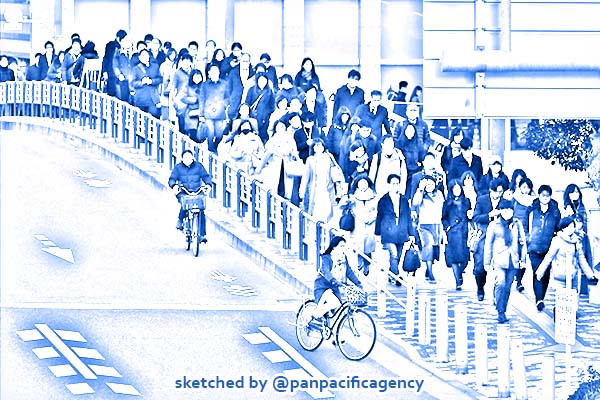Japan to lift coronavirus emergency outside Tokyo, Osaka regions

People wear masks as they commute during the morning rush hour Friday in Tokyo. Photo: AP/Kiichiro Sato. Sketched by the Pan Pacific Agency.
TOKYO, May 14, 2020, Kyodo. The Japanese government decided Thursday to lift a state of emergency for 39 of the country’s 47 prefectures where the novel coronavirus is currently not spreading widely ahead of the measure’s planned expiry at the end of this month, Kyodo News reported.
Urban regions such as Tokyo and Osaka, however, will likely remain under the state of emergency to ensure newly reported cases continue to fall and that the burden on hospitals eases.
Infectious disease and public health experts will analyze up-to-date data on the spread of the virus and the situation faced by hospitals.
Economic revitalization minister Yasutoshi Nishimura said the total number of reported cases has been falling in the 39 prefectures, adding that they have enough capacity to provide medical care.
“We believe it’s appropriate to lift the state of emergency for the prefectures,” Nishimura told an advisory panel in charge of assessing whether a lifting is warranted.
One of those prefectures — Ehime, a southwestern Japan prefecture that has seen a rise in cases due to group infections at a hospital — will need to keep tracking and reporting on the situation.
The 39 also include five prefectures — Ibaraki, Ishikawa, Gifu, Aichi and Fukuoka — which were classified as requiring “special caution” due to their large number of coronavirus cases.
Those that are expected to remain under the state of emergency are Hokkaido, the Tokyo metropolitan area also encompassing Chiba, Kanagawa and Saitama, as well as Kyoto, Osaka and Hyogo.
Following the panel’s assessment, Prime Minister Shinzo Abe will finalize his decision and explain it to the public during a press conference at 6 p.m.
He is being pressed to strike the right balance in preventing a reversal of the recent downward trend in daily reported cases and allowing economic activity to resume in stages.
Based on expert recommendations, the government has been encouraging people to adopt a new lifestyle without letting their guard down in what is now expected to be a protracted battle against the virus.
The government will continue to request that people avoid travel between areas that are still under the state of emergency and those that are not. They will also be asked to avoid confined and crowded places and close contact with people.
Alarmed by the prospect of an explosive surge in new COVID-19 cases during the Golden Week holidays from late April to early May, the government stepped up calls for reducing person-to-person contact and avoiding travel beyond prefectural borders.
Abe initially declared a one-month state of emergency until May 6 for seven urban areas hit hard by the new coronavirus in early April. He then expanded it to the entire nation on April 16 before extending it to May 31.
He said the extension was critical for Japan to tackle the coronavirus crisis, which has dealt a heavy blow to the economy, but that the emergency could end sooner for some prefectures depending on the infection situation.
Prefectural governors have been asking people to stay at home and businesses to close temporarily, using authority to make such requests granted under the emergency declaration. Following the requests is voluntary and no penalties are imposed for non-compliance.
Tokyo, hit hardest by the virus among the 47 prefectures, has seen cases fall to double-digit levels in recent days after the daily count surged to over 200 in April.
But the metropolitan government has said it will maintain its business suspension request until May 31, when the current state of emergency is slated to expire.
Osaka Gov. Hirofumi Yoshimura, meanwhile, has set out the prefecture’s own criteria for easing curbs on business activity, and other governors have followed suit.
Japan has avoided an explosive rise in infections but over 16,700 cases and 690 deaths have been confirmed so far. The tally includes about 700 from the Diamond Princess cruise ship that was quarantined near Tokyo in February.